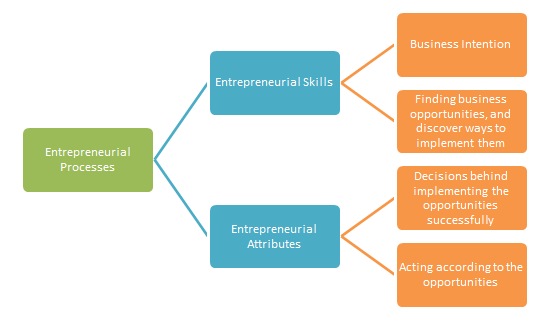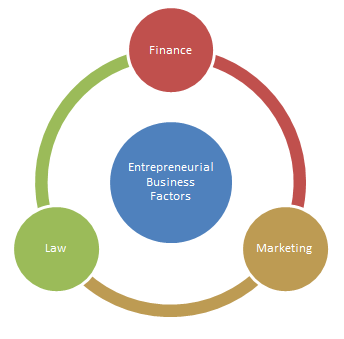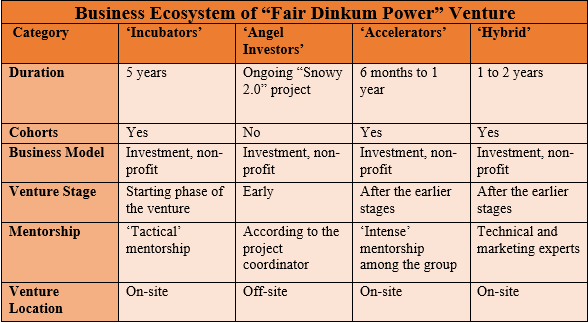In-depth Analysis Of Fair Dinkum Power Venture
Question
Task: Perform a critical analysis and prepare a report on the entrepreneurial ecosystem, operational processes, business factors and future planning of the Fair Dinkum Power venture.
Answer
‘Executive Summary’
The following analysis on Fair Dinkum Power venture is based on an entrepreneurship company from Australia that specializes in providing renewable energy power sources to the households of Australia. They are also conducting collaboration with the 'Federal Government' of Australia to make the campaign of using ‘solar’ and ‘wind’ energy by replacing the traditional energy sources. The government also made a financial investment into its renewable energy project called "Snowy 2.0," collaborating with the Fair Dinkum Power venture. The company is also engaged with the largest ‘solar energy’ farm with an investment of billions of dollars. The following analysis report will shed light on the entrepreneurial ecosystem, operational processes, business factors, and future planning of the Fair Dinkum Power venture.
1. Introduction
1.1 Overview of the Entrepreneurial Venture: “Fair Dinkum Power”
a) Nature of the Fair Dinkum Power venture: “Fair Dinkum Power” is an entrepreneurial project by an Australian billionaire, Mike Cannon-Brookes, to sustain the renewable energy resources and its usage. The company has initially been launched by Scott Morrison to fulfil the government's journey of providing renewable energy to every Australian household. The original concept of this project is coined by the Australian Federal Government to promote the productivity and usage of renewable energy. The environmental challenges and the demand for sustaining the essentials of daily life make this Fair Dinkum Power venture to starting the journey against the rising electricity bills of the Australian citizens, and global threats (Gilley, 2019).
b) Economic Impact
More than 2 billion houses in Australia are planning to shift on using renewable energy. However, they only belong to 20 percent of the energy market, and companies cannot let them use the facility at a lower price. "Fair Dinkum Power" is planning to provide solar energy resources to 400,000 houses in Australia (Gilley, 2019). It can reduce the average electricity costs by 50 percent. The new "Snowy 2.0" project of renewable energy has undertaken by the "Fair Dinkum Power" with an investment of '$1.38 billion' from the government (The Australian, 2019).
1.2 The ecosystem of the venture
As an entrepreneurship venture, "Fair Dinkum Power" has an elaborate ecosystem that includes the individual functions of 'incubators,' 'angel investors,' 'accelerators,' and 'hybrid' business outsources (see ‘Appendices’ section). The current project of “Fair Dinkum Power” has assigned its ‘angel investors’ is the 'Federal Government' of Australia. The company has attributed its external 'incubators' and 'accelerators' for a different duration to upscale the business procedures, and provide a physical existence of the Fair Dinkum Power venture. The business 'hybrid' will help in promoting the company with the help of technical mechanisms to reach maximum potential consumers.
2. Analysis of the Internal Processes of the Venture
2.1 Entrepreneurial Opportunities
Entrepreneurial opportunities of a Fair Dinkum Power venture are related to the company's social acceptances, and capitals to make the outside entities trust upon the business operations. Various works of literature have mentioned that the ventures, which are successful in acquiring a healthy social perspective, can discover and enhance more entrepreneurial opportunities to sustain the enterprise (Nieto & González-Álvarez, 2016). The “Fair Dinkum Power” has been established for a good cause and gained support from millions of citizens in Australia. They are now able to make decisions to use renewable energy sources for sustaining the resources with the venture’s influence. The entrepreneurial opportunities for Fair Dinkum Power venture is enormous, as the government and people of Australia are ready to help them to succeed in their mission.
2.2 Fair Dinkum Power venture Processes and Framework
The entrepreneurial ventures need to make initial business and progress planning with a specific goal to make their effort behind that. Networking is an essential prospect for entrepreneurs to manage stressful situations during uncertainty (Engel, Kaandorp, & Elfring, 2017). The Fair Dinkum Power venture has also started their journey by building a plan in their head and started to target potential people to fulfil their goals. They were aware of the Australian government's initiative to make renewable energy into practical life.

Fig 1: Entrepreneurial Business Processes
The venture has started to interact with the people that are willing to replace their traditional source of energy with the help of the government's investment. The venture has been working on its framework by inviting the "Energy Security Board" of Australia into their committee. "Australian Government Energy Council" collaborated with “Fair Dinkum Power” to develop its energy resource market (Pearson, 2019). They have taken some processes, such as implementing ‘power generator’ technologies, connecting with ‘wind’ and ‘solar’ farm networks, and increasing the distribution of renewable energy sources (Pearson, 2019).
2.3 Business Growth Factors
The demand for sustainable energy resources in developed countries to mitigate the environmental pollution caused by traditional sources. In the present scenario, the effective and available alternative to conventional energy sources is the renewable energy that can save the environment and energy costs (Baruah, Ward, Jackson, & Gbadebo, 2018). It is the main motive behind the business growth of the Fair Dinkum Power venture to provide the appropriate mechanisms to use renewable energy in the daily essentials. They have acquired the government's project of providing renewable energy to every house in Australia. It is a sustainable business step for the venture with the help of the government's fund.
3. Analysis of the Venture’s Progress
3.1 Entrepreneurial Business Factors
a) Finance: The entrepreneurial finance of the Fair Dinkum Power venture will be based on their financial decisions collaborating with the government. This process is different than an old established venture. The entrepreneurial finance of an enterprise is also related to technology and identifies the building process (Audretsch, Lehmann, Paleari, & Vismara, 2016). The company has taken the initiative to transform 100 percent of households into renewable energy power in Australia. The owner of the company has invested $25 billion to his "Sun Cable" project, which is the largest farm for 'solar' energy (Bailey, 2019).
b) Law
The Fair Dinkum Power venture has been granted by the Australian government to operate its project of promoting sustainable energy resources to the people. The government has invested in the “Snowy 2.0” project that can enlighten millions of homes in Australia. The entrepreneurial law related to operating the business is less complicated than other ventures, which are not backed by the government directly.
c) Marketing
The marketing structure of “Fair Dinkum Power” is related to innovation risks and risk-taking decisions to sustain business operations. The authority has already taken their business decisions with immense support from the people and government of Australia. They are continuously influencing the people to be aware of using renewable energy sources to mitigate the increasing global pollution, and sustaining the energy resources. It is the marketing 'USP' of the “Fair Dinkum Power” venture.

Fig 2: Entrepreneurial Business Factors
3.2 Entrepreneurship Sustainability
Various institutions and government officials wanted to decrease the usage of traditional energy sources to prevent the environment from getting polluted from the dangerous 'carbon emission.' "Fair Dinkum Power" has started its operation to sustain the energy resources by promoting renewable energy. It will decline the average electricity cost and a reliable source for sustainable energy consumption (Cass & Merzian, 2019). The sustainability of an entrepreneur company is dependable on its production and requirement in the consumer. Fair Dinkum Power venture has successfully innovated their operation to make the lives of Australian households' pollution-free. They are also trying to lower the price of their 'solar' energy batteries to make affordable for every home. It has already crossed 2 million houses from both rural and urban areas (Cass & Merzian, 2019).
3.3 ‘Harvest’ Planning of the Venture
Entrepreneurs are often looking to build considerable value from their company to sell it at a higher price to gain a good amount of money (Mathias, Solomon, & Madison, 2017). It is a strategical way to extract maximum value out of a successful company to build another one. The founder of "Fair Dinkum Power," Mike Cannon-Brooks, is also the co-founder of the "Atlassian" software 'development and collaboration' company, which has a value of $38 billion. The company has already established its network with almost 138,000 organizations globally. The establishment of "Fair Dinkum Power" is to raise awareness against the harmful threats from the traditional energy resources, and its heavy consumption. The venture is determined to fulfil the journey of making every household of Australia sustained with renewable energy. The company has not made any plan on trading the company to other organizations, as they are not interested in making a profit out of it.
4. Conclusion
The current entrepreneurial venture analysis has established various business initiatives, business processes, collaboration structure, and other aspects of Fair Dinkum Power venture elaborately. Mike Cannon-Brooks has formed this venture to make an effective campaign against the negative impacts of 'fossil fuels' and other traditional resources of energy production. It is one of the biggest threats to the environment in the present scenario and has no sustainability. It is essential to enable an energy resource that is sustainable and has a positive impact on the environment. Renewable energy sources are the only existing and viable alternative to make energy consumption sustainable. The government and people of Australia are ready to adopt this technology in their daily essentials. The company is looking forward to completing its desire to make Australia green and sustained.
5. Appendices
5.1 Entrepreneurial Ecosystem of “Fair Dinkum Power” Venture

6. Bibliography
Audretsch, D., Lehmann, E., Paleari, S., & Vismara, S. (2016). Entrepreneurial finance and technology transfer. The Journal of Technology Transfer, 41(1), 1-9.
Bailey, M. (2019, November 28th). Cannon-Brookes pulls plug on Fair Dinkum Power company. Fair Dinkum Power venture Retrieved from Financial Review: https://www.afr.com/companies/energy/cannon-brookes-pulls-plug-on-fair-dinkum-power-20191128-p53ezg
Baruah, B., Ward, T., Jackson, N., & Gbadebo, A. (2018). Addressing the skills gap for facilitating renewable energy entrepreneurship—An analysis of the wind energy sector. 2018 Majan International Conference (MIC) (pp. 1-7). IEEE.
Cass, D., & Merzian, R. (2019, February 15th). Fair Dinkum Power Senate Submission. Retrieved from The Australian Institute : https://www.tai.org.au/content/fair-dinkum-power-senate-submission
Engel, Y., Kaandorp, M., & Elfring, T. (2017). Toward a dynamic process model of entrepreneurial networking under uncertainty. Journal of Business Venturing, 32(1), 35-51.
Gilley, N. F. (2019, April 30). Fair dinkum power needs more everyday Australians and fewer big electricity retailers. Retrieved from SmartCompany: https://www.smartcompany.com.au/industries/energy-resources/fair-dinkum-power/
Mathias, B., Solomon, S., & Madison, K. (2017). After the harvest: A stewardship perspective on entrepreneurship and philanthropy. Journal of Business Venturing, 32(4), 385-404.
Nieto, M., & González-Álvarez, N. (2016). Social capital effects on the discovery and exploitation of entrepreneurial opportunities. International Entrepreneurship and Management Journal, 12(2), 507-530.
Pearson, A. (2019, March 18th). Senate Select Committee into Fair Dinkum Power. Fair Dinkum Power venture Retrieved from AEMC: https://www.aemc.gov.au/news-centre/media-releases/senate-select-committee-fair-dinkum-power
The Australian. (2019, February 26th). Snowy 2.0 real fair dinkum power: Scott Morrison. Retrieved from The Australian: https://www.theaustralian.com.au/subscribe/news/1/?sourceCode=TAWEB_WRE170_a_GGL&dest=https%3A%2F%2Fwww.theaustralian.com.au%2Fnation%2Fpolitics%2Fsnowy-20-real-fair-dinkum-power-scott-morrison%2Fnews-story%2F2c0e860fe07af536336a909ac9512193&memtype=anony












